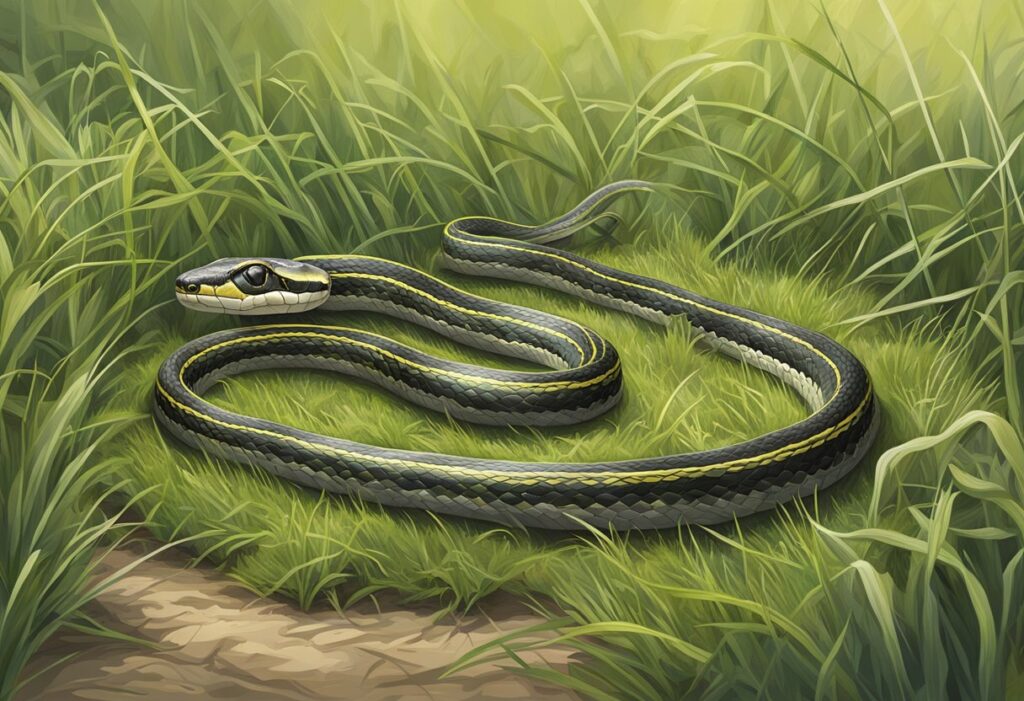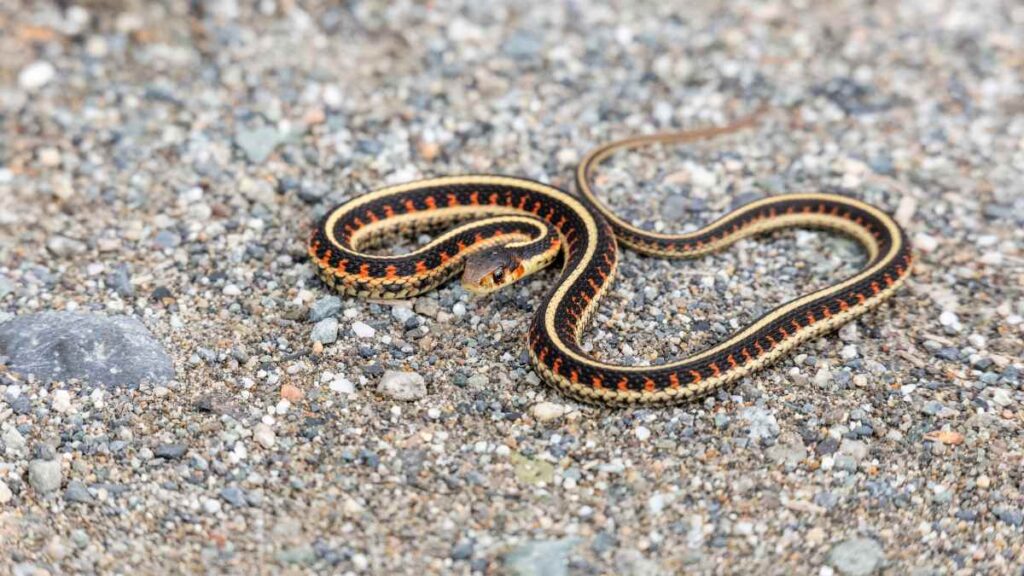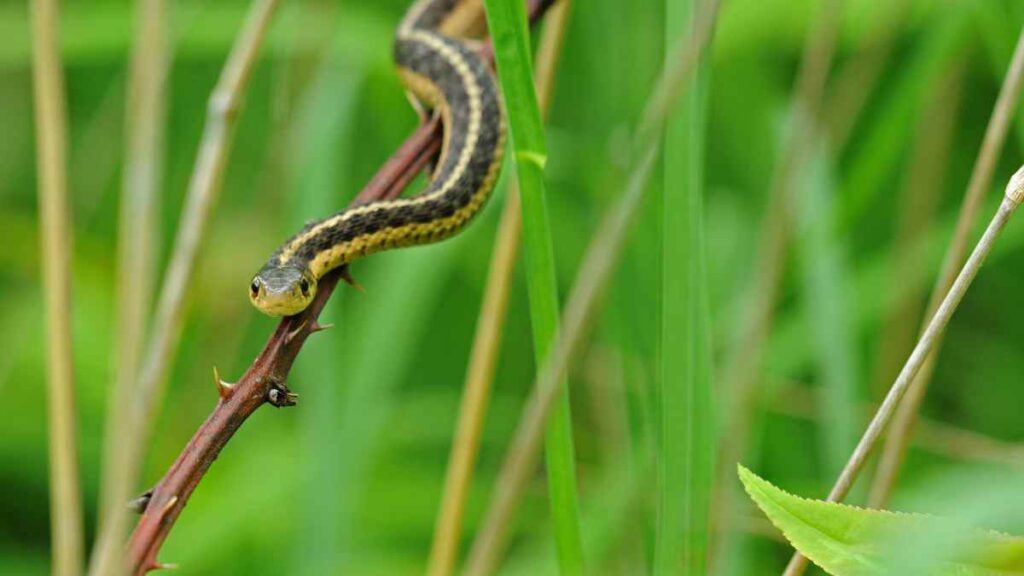Are garter snakes good? If you’re a gardener, the answer is a resounding “yes!” Garter snakes are harmless to humans and can actually be helpful in controlling garden pests like slugs and insects.
These snakes can be found all across North America in a variety of habitats, including meadows, woodlands, and grassy areas near water sources.

Garter snakes are thin and have distinctive stripes running down their backs. They are cold-blooded and eat a variety of foods, including small rodents, frogs, and earthworms. While they are not venomous, they do release a musk when threatened. If you come across a garter snake in your garden, there’s no need to be alarmed. They are harmless and actually beneficial to have around.
If you’re considering keeping a garter snake as a pet, they can be a good choice for beginners. They are easy to care for and will eat a variety of prey sources. However, it’s important to remember that wild-caught snakes can carry diseases and parasites, so it’s best to get a captive-bred snake from a reputable breeder. Overall, garter snakes are a fascinating and harmless addition to any ecosystem.
Understanding Garter Snakes

Garter snakes are a fascinating species that are commonly found in North America. They are known for their distinctive stripes, which can be yellow, green, or brown in color. This section will explore the physical characteristics, habitats and distribution, and diet and feeding habits of garter snakes.
Physical Characteristics
Garter snakes are relatively small in size, with the common garter snake (Thamnophis sirtalis) averaging between 18 and 26 inches in length. They have smooth scales, typically brown or green, with stripes running down their bodies. These stripes can be one or multiple colors and are an identifying characteristic of the species.
Habitats and Distribution
Garter snakes are found throughout North America, from Canada to the United States. They prefer to live in areas with plenty of shelter, such as grasslands, forests, and wetlands. Garter snakes are also commonly found in suburban and urban areas, where they can find shelter in gardens and under debris.
Diet and Feeding Habits
Garter snakes are carnivorous and feed on a variety of prey, including earthworms, slugs, mice, frogs, invertebrates, and small rodents. They are opportunistic feeders and will eat almost anything they can catch. Garter snakes are important predators in their ecosystems and help to control populations of pests and other small animals.
In conclusion, garter snakes are a friendly species that play an important role in their ecosystems. They are small in size, prefer habitats with plenty of shelter, and feed on a variety of prey. If you are lucky enough to spot a garter snake in the wild, take a moment to appreciate their unique physical characteristics and important role in the ecosystem.
Garter Snakes as Pets
Garter snakes are a popular choice for pets, especially for beginners who are just starting to explore the world of reptile keeping. They are small, relatively easy to care for, and come in a variety of colors and patterns. However, before you decide to bring a garter snake into your home, there are a few things you should consider.
Housing and Care
When it comes to housing your garter snake, you will need to provide them with an enclosure that is large enough for them to move around comfortably. A 20-gallon aquarium or similar-sized enclosure is usually sufficient for one or two adult garter snakes. Make sure the enclosure has a secure lid to prevent escape.
Garter snakes are cold-blooded, which means they rely on external heat sources to regulate their body temperature. You will need to provide a heat source, such as a heat lamp or under-tank heating pad, to keep the enclosure at the proper temperature.
Garter snakes also need a place to hide, such as a small box or piece of wood, as well as a water dish for drinking and soaking. The enclosure should be cleaned regularly to prevent the buildup of waste and bacteria.
Health Concerns
Like all pets, garter snakes can develop health problems. Some of the most common health concerns for garter snakes include respiratory infections, skin infections, and parasites such as ticks and mites.
To keep your garter snake healthy, it is important to provide them with a clean and well-maintained enclosure. You should also monitor your snake for any signs of illness, such as wheezing, discharge from the nose or mouth, or lethargy.
If you suspect your garter snake is sick, it is important to take them to a reptile veterinarian as soon as possible. With proper care, however, garter snakes can live for several years in captivity.
Overall, garter snakes can make great pets for those who are willing to provide them with the proper care and attention they need. With a little bit of research and preparation, you can enjoy the company of these fascinating and friendly reptiles in your own home.
Garter Snakes in the Garden
If you are a gardener, you may have noticed garter snakes slithering through your garden. While some people may be frightened by the sight of a snake, garter snakes can actually be beneficial to your garden ecosystem. In this section, we will discuss the benefits and drawbacks of having garter snakes in your garden, as well as how to attract or remove them.
Benefits and Drawbacks
Garter snakes are natural predators and can help control pest populations in your garden. They primarily feed on insects, slugs, and worms, which can cause damage to your plants. By having garter snakes in your garden, you can reduce the need for pesticides and other harmful chemicals. However, garter snakes can also cause damage to your garden if they decide to burrow or hibernate in your garden beds. Additionally, garter snakes may emit a musk if they feel threatened, which can be unpleasant.
Attracting and Removing Garter Snakes
If you want to attract garter snakes to your garden, you can create a suitable habitat for them. Garter snakes prefer grassy areas with access to water and shelter. You can create a suitable substrate for them by using building materials such as bricks or stones. Additionally, you can provide a hibernation site by creating a pile of leaves or logs. If you want to remove garter snakes from your garden, you can use humane methods such as placing a barrier around your garden or using a snake trap. It is important to note that garter snakes are harmless and should not be killed or harmed.
In summary, garter snakes can be a gardener’s friend by controlling pest populations in your garden. However, they can also cause damage if they decide to burrow or hibernate in your garden beds. If you want to attract or remove garter snakes from your garden, there are humane methods you can use.
Conclusion

Garter snakes can make great pets for those who are looking for a low-maintenance and friendly companion. They are non-venomous snakes that are generally harmless to humans, making them safe to handle and interact with.
However, it is important to keep in mind that garter snakes are still wild animals and may not be suitable for everyone. They can be difficult to handle and may require special care, such as a specific diet or habitat.
It is also important to consider the impact of keeping garter snakes as pets on their natural habitat and conservation efforts. While garter snakes are not endangered, they play an important role in the ecosystem as predators of small animals such as insects and rodents.
Overall, if you are interested in keeping a garter snake as a pet, it is important to research and ensure that you are prepared to provide the necessary care and attention. Additionally, it is important to consider the impact of your decision on the environment and the conservation of these fascinating creatures.



